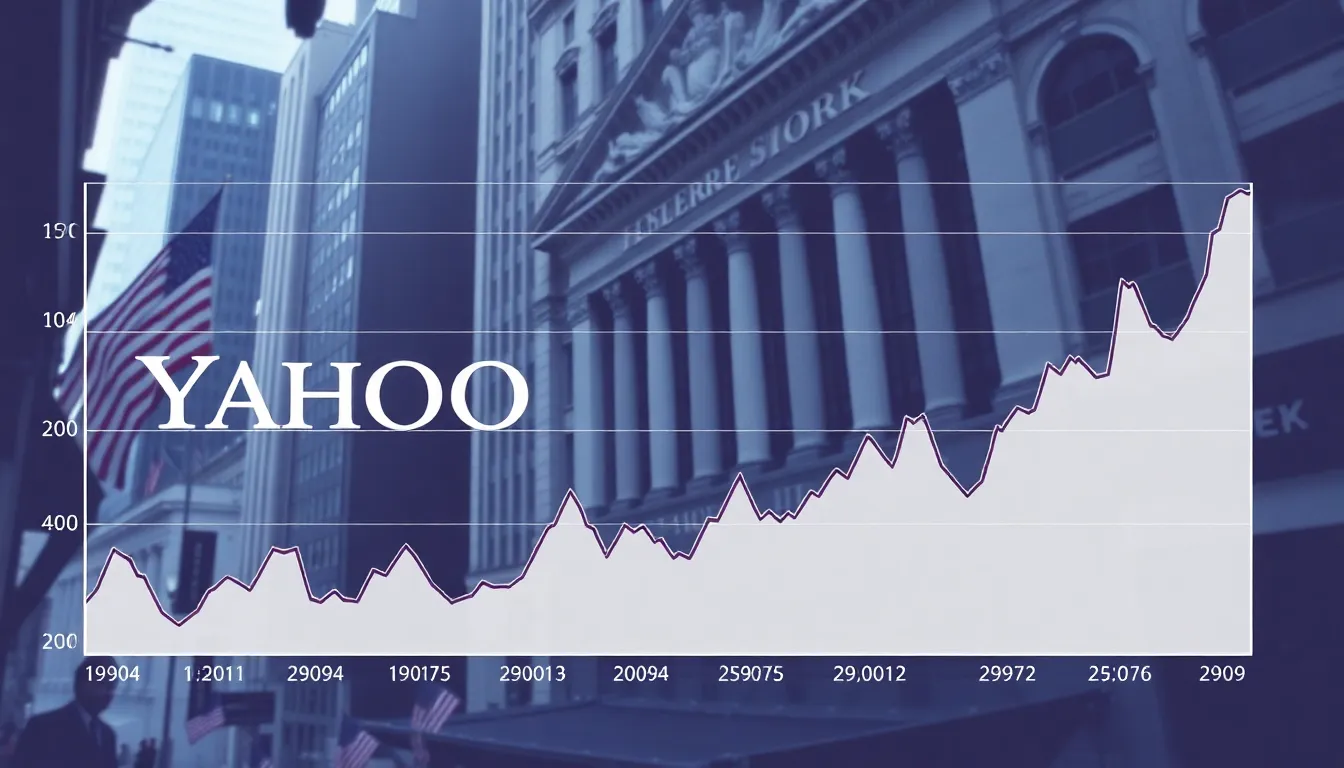Yahoo’s stock price history is a rollercoaster ride that even the bravest investors might hesitate to board. From its meteoric rise during the dot-com boom to the dizzying plummet that followed, Yahoo’s journey is a cautionary tale wrapped in a tech fairy tale. Imagine investing in a company that once seemed invincible, only to watch it transform into a cautionary tale of missed opportunities and questionable decisions.
Table of Contents
ToggleOverview of Yahoo Stock Price History
Yahoo’s stock price history reflects significant highs and lows since its initial public offering (IPO) in 1996. Initially, it soared to nearly $120 per share during the dot-com boom in 2000. This peak marked a milestone for the company, driven by intense market enthusiasm for internet-based businesses.
Following the rapid ascent, Yahoo faced considerable challenges, leading to a steady decline. The stock fell to around $13 per share by 2008, demonstrating the impact of strategic missteps and increased competition from companies like Google and Facebook. Investors experienced uncertainty during this period as changes in leadership had a profound effect on the company’s direction.
In 2013, Yahoo attempted to rejuvenate its brand by acquiring Tumblr for approximately $1.1 billion. Despite this bold move, the stock remained volatile. Prices fluctuated significantly as investors weighed the effectiveness of the acquisition against ongoing revenue struggles.
By 2016, Verizon acquired Yahoo’s core internet business for $4.48 billion. This acquisition marked a critical transition in Yahoo’s history as it moved towards a new chapter under Verizon’s ownership. The price per share settled around $5. During this time, the stock reflected a stark contrast to the company’s peak performance, highlighting its transformation from a tech leader to a struggling entity.
Ultimately, Yahoo’s stock price history serves as a compelling case study of success, setbacks, and corporate evolution in the technology sector. Each phase showcases important lessons in innovation, market dynamics, and strategic decision-making.
Key Milestones in Yahoo’s Stock Price

Yahoo’s stock price history features significant milestones that mark its rise and fall in the tech industry.
IPO and Early Years
Yahoo went public in April 1996, with an initial offering price of $13 per share. The stock gained immense popularity, notably soaring to nearly $120 per share by the height of the dot-com boom in March 2000. This rapid increase reflected the immense optimism surrounding internet-based companies during that period. Investors were eager to capitalize on Yahoo’s growth potential, confident in its ability to dominate the online space. The stock’s remarkable trajectory positioned Yahoo as a leading internet corporation early on, highlighting its relevance in a rapidly evolving market.
Major Price Fluctuations
After reaching its peak in 2000, Yahoo’s stock faced significant challenges, characterized by drastic fluctuations. By 2008, its price had fallen to around $13 per share, influenced by strategic missteps and intensified competition from rivals like Google and Facebook. This decline illustrated the volatility in technology stocks. The acquisition of Tumblr in 2013 for approximately $1.1 billion aimed to reinvigorate its brand but resulted in continued fluctuations as investors evaluated its impact. In 2016, Verizon’s acquisition of Yahoo’s core internet business for $4.48 billion marked another pivotal moment, with the stock stabilizing around $5 per share.
Factors Influencing Yahoo’s Stock Price
Several elements significantly impacted Yahoo’s stock price over the years. These factors range from market trends to company-specific performance metrics.
Market Trends
Market trends played a crucial role in shaping Yahoo’s stock trajectory. During the late 1990s and early 2000s, investor enthusiasm for internet firms drove stock prices to unprecedented heights. A surge in the tech sector resulted in Yahoo’s stock peaking at nearly $120 per share in 2000. This peak corresponded with broader market euphoria surrounding dot-com companies. In contrast, the burst of the dot-com bubble in 2001 marked the beginning of Yahoo’s decline. Increasing competition from firms like Google and Facebook further exacerbated this descent, and shifting consumer interests altered the landscape, impacting overall market sentiment toward Yahoo.
Company Performance
Company performance directly influenced Yahoo’s stock valuation. From its IPO in 1996, leadership decisions shaped investor confidence. Strategic missteps during critical growth phases reflected negatively on Yahoo’s earnings prospects. For instance, acquiring Tumblr in 2013 for about $1.1 billion did not lead to the expected revenue boost, revealing weaknesses in execution. Performance metrics, such as revenue growth and profit margins, became increasingly scrutinized. The sale of Yahoo’s core internet business to Verizon in 2016 for $4.48 billion concluded a complex narrative of fluctuating stock value, emphasizing the importance of effective management and strategic direction in determining stock price.
Yahoo’s Stock Price Post-Acquisition
Yahoo’s stock price underwent significant changes following its acquisition by Verizon in 2016. The purchase price of $4.48 billion marked a pivotal moment for Yahoo as it transitioned from a tech leader to a subsidiary of a telecommunications giant. Post-acquisition, the stock initially settled around $5 per share, reflecting the challenges faced in the competitive digital landscape.
Investors reacted cautiously to the acquisition, weighing potential growth opportunities against ongoing revenue struggles. Verizon aimed to revitalize Yahoo, yet the legacy of missed opportunities lingered. By mid-2017, the stock experienced fluctuations, largely due to shifts in investor sentiment and competition with other platforms.
Analysts noted that Yahoo’s integration into Verizon’s portfolio influenced its stock performance. Under Verizon, efforts were made to streamline operations and improve user engagement metrics. Innovations within the Yahoo brand, including enhancements to its advertising capabilities, introduced some optimism among investors.
The market’s reaction highlighted the struggle for growth amid evolving technologies. Investors remained concerned regarding Yahoo’s ability to compete effectively against industry rivals like Google and Facebook. Continued challenges in adapting to consumer preferences led to volatility in share prices.
Yahoo’s post-acquisition phase illustrates ongoing challenges for established brands in the tech sector. Decisions made during this period shaped investor confidence and directly impacted stock valuation. Ultimately, the transition period under Verizon represents a critical chapter in understanding Yahoo’s shifting market position and lasting legacy in the tech industry.
Yahoo’s stock price history is a vivid illustration of the volatile nature of the tech industry. From its meteoric rise during the dot-com boom to its eventual decline, the company’s journey reflects the complexities of innovation and market dynamics.
The lessons learned from Yahoo’s challenges underscore the importance of strategic decision-making in maintaining competitive advantage. As it continues to evolve under Verizon’s ownership, the legacy of Yahoo remains a poignant reminder of how quickly fortunes can change in the fast-paced world of technology. Investors and industry observers alike will benefit from understanding these historical trends as they navigate future opportunities and challenges in the tech landscape.




